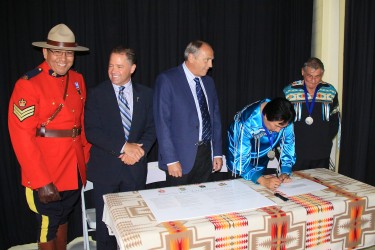Article Origin
Volume
Issue
Year
Industry has one more First Nation to consult when looking to do work in northern Alberta.
A special ceremony was held Sept. 12 that celebrated the conclusion of years of negotiation that resulted in the creation of the province’s 45th First Nation.
Peerless Trout First Nation was created through the settlement of the Bigstone Cree First Nation specific claim, the largest claim ever concluded in Alberta. The settlement resolved outstanding issues relating to treaty promises dating back to the late 1800s.
When the first lands for the reserve were surveyed in 1913, the size of the reserve was calculated at 128 acres per person based on membership. However, membership north of Bigstone Cree Nation was not taken into consideration, and although this oversight was discovered, no new reserve lands were added to compensate for the additional members once they were counted.
It wasn’t until 1998 that Bigstone Cree’s shortfall claim was allowed to proceed under Canada’s Historic Treaty Land Entitlement Policy and its Specific Claims Policy. The Ancillary Treaty Benefits claims were accepted for negotiation by Canada in 2006 and 2007.
The settlement includes approximately $259 million and up to 140,000 acres of unoccupied provincial Crown land to become new reserve land for the First Nations. Peerless Trout First Nation will receive 63,000 acres while, 77,000 acres will be set aside for new reserves around the Bigstone communities of Wabasca, Calling Lake, and Chipewyan Lake.
“We’ve been waiting a long time for this,” said Peerless Trout Nation Chief James Alook. The Peerless Trout First Nation was officially constituted on May 19, 2010. Alook was elected to his position a month later.
The celebrations took place at Wabasca, one of the three communities retained by Bigstone Cree Nation. Alook was joined by Bigstone Cree Chief Gordon Auger.
“This landmark settlement marks a new beginning for the Bigstone and Peerless Trout First Nations, opening up new opportunities for economic development that will bring long-term benefits to the lives of First Nation members,” said Aboriginal Affairs and Northern Development Canada Minister John Duncan, who also took part in the celebration.
Working with industry – gas, oil and forestry – is important, said Alook.
“We won’t depend on handouts. I don’t see myself as that in the future. There are lots of opportunities in this area,” he said.
Alook said he wanted his community to be self-reliant, and that will come through the development of natural resources in the area and promotion of tourism.
Webber stressed that industry wanting to operate in the area would have to consult with First Nations.
Consultation is what the provincial government wants, said Alberta Aboriginal Affairs Minister Len Webber.
“It would mean that industry will have to consult with two First Nations now,” he said. “It wouldn’t be easier for industry … (but) it would be important that they do consult.”
The Lower Athabasca Regional Plan, which is the first regional watershed plan created by the provincial government, sets out guidelines for industry development and protected areas and sets consultation with First Nations as a priority.
“There can be good relations between the government and First Nations and between the First Nations and industry,” said Webber.
The province’s contribution in this settlement agreement includes $28 million and a commitment to construct two new elementary schools in Peerless Lake and Trout Lake, as well as water treatment plants for each of these communities.
Other capital dollars will be spent on housing which is a priority, said Alook, along with social development.
“We are making progress on building our new community,” he said.
Since 1986, the provincial government has completed 13 land claims.
“The fact we can negotiate a settlement means we can work with each other in a cooperative manner,” said Webber.
- 4579 views

